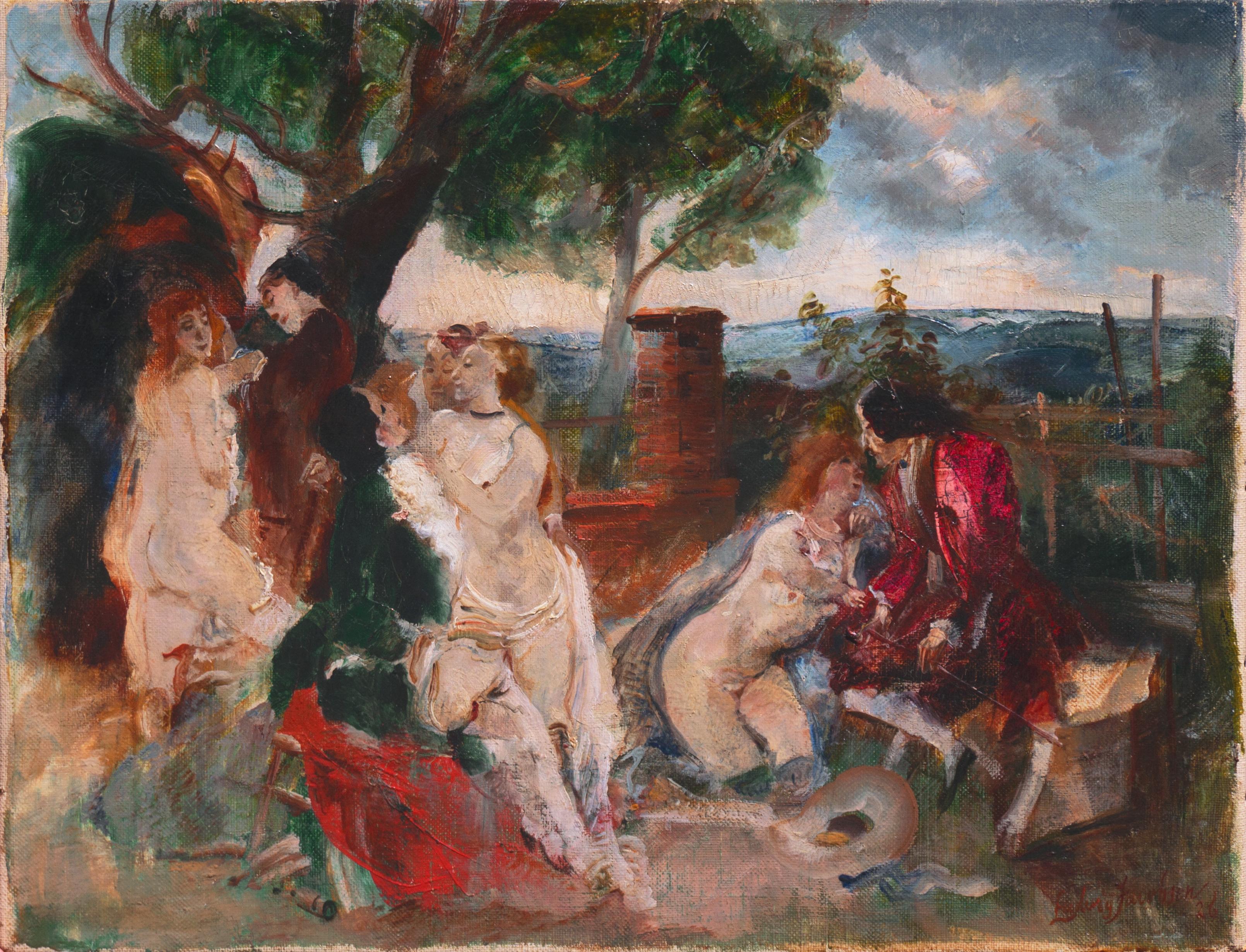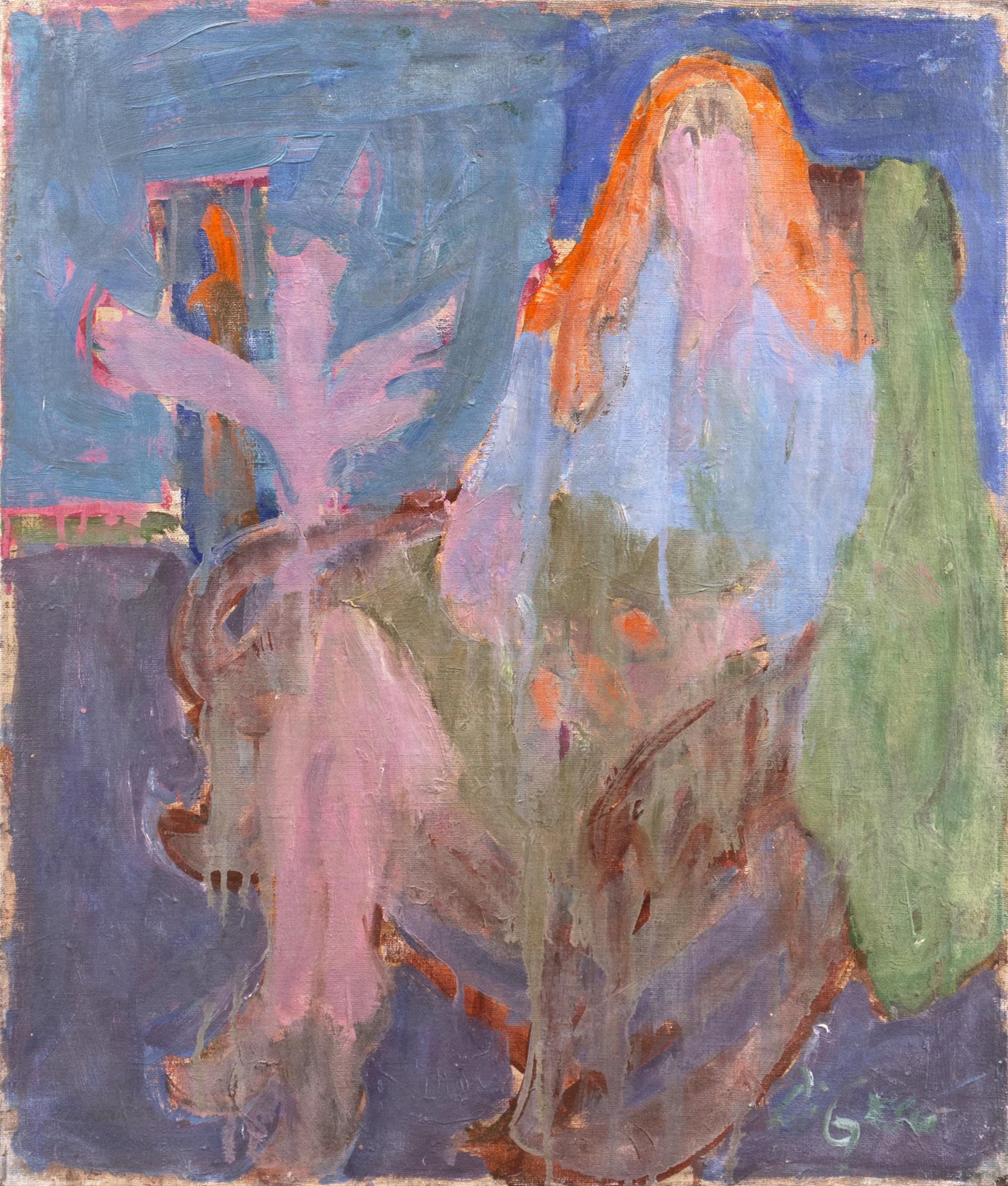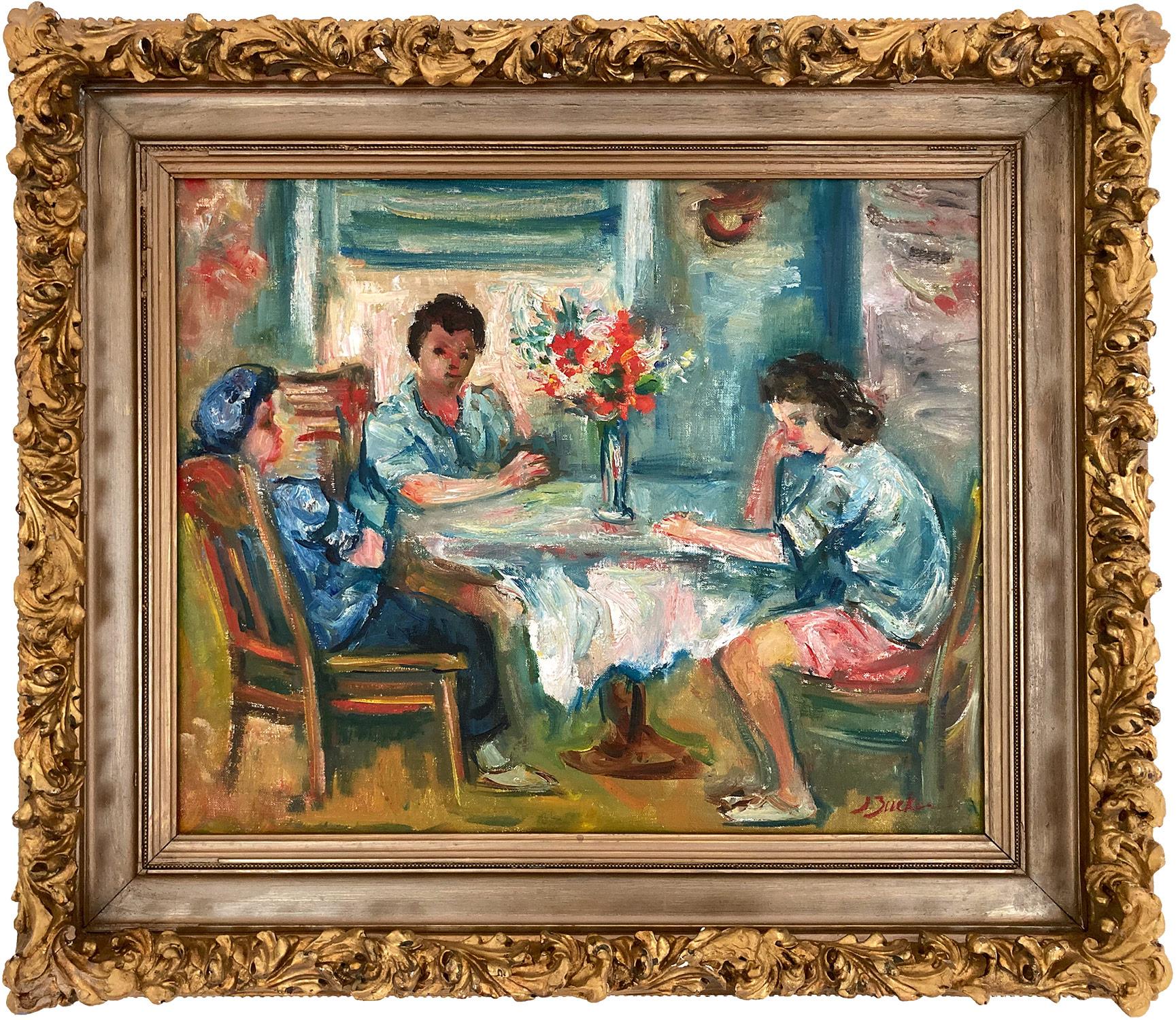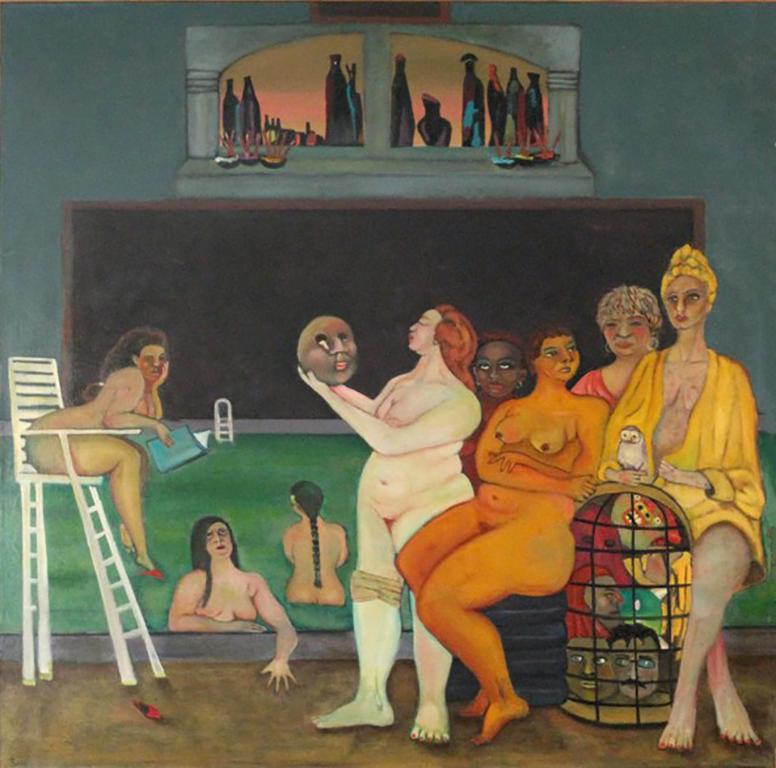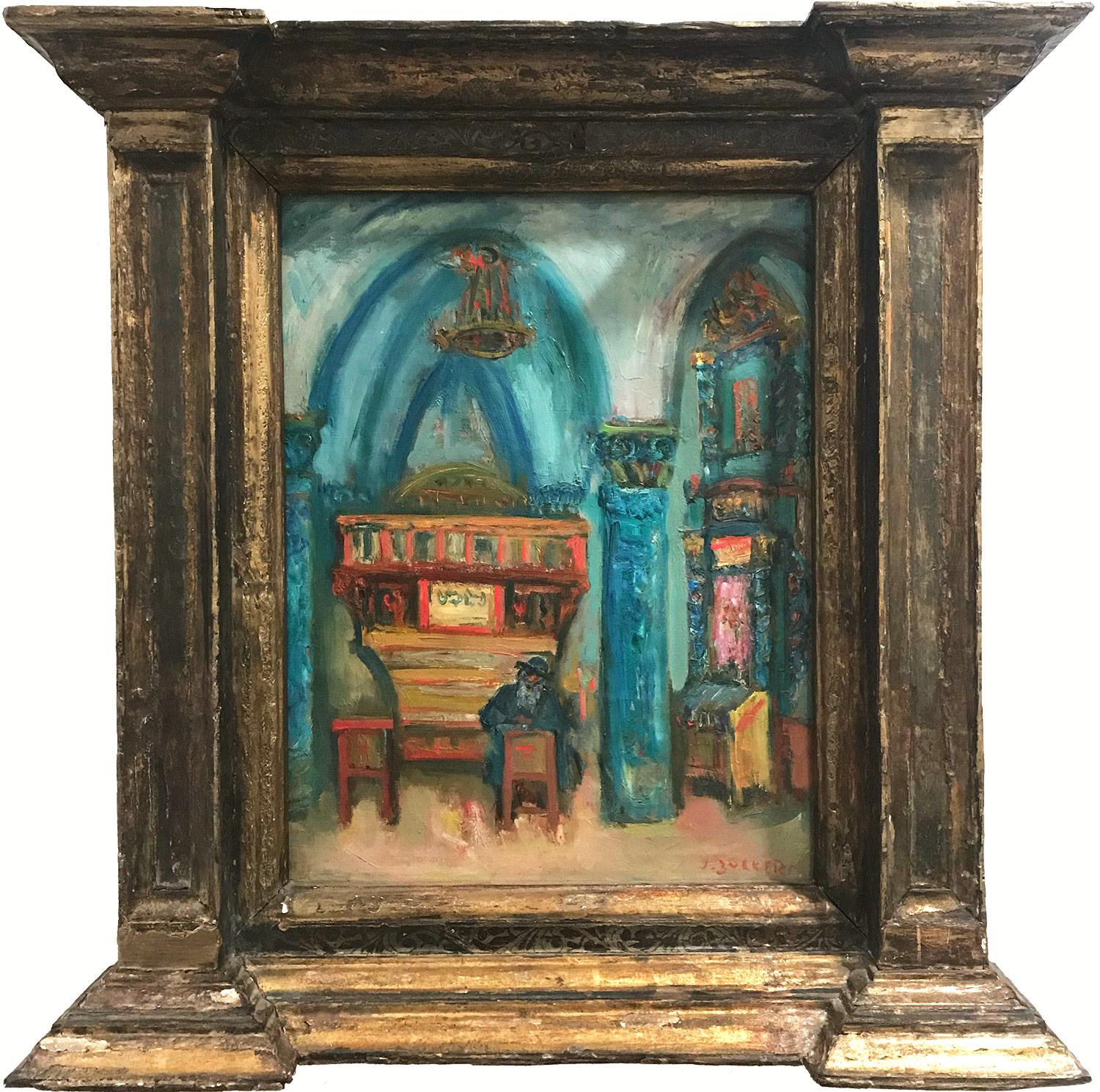Items Similar to Maternite - Post Impressionist Figurative Interior Oil Painting - Henri Lebasque
Want more images or videos?
Request additional images or videos from the seller
1 of 17
Henri LebasqueMaternite - Post Impressionist Figurative Interior Oil Painting - Henri Lebasquec.1910
c.1910
About the Item
Signed figurative oil on canvas circa 1910 by French post impressionist painter Henri Lebasque. The work depicts a mother seated on a yellow change feeding her young baby.
Signature:
Signed lower right
Dimensions:
Framed: 16"x19"
Unframed: 11"x14"
Provenance:
Private French collection
The authenticity of this work has been confirmed by Mme. Denise Bazetoux
This work will be included in the forthcoming supplement to the Catalogue Raisonné under preparation by Mme. Denise Bazetoux
Henri Lebasque studied at the École des Beaux-Arts in Angers, then, after moving to Paris in 1886, studied briefly under Bonnat, then under Humbert, whom he assisted in the decoration of the Panthéon. More importantly, he met and learned from Pissarro.
In 1893 he met Luce and Signac at the Salon des Indépendants, and as a result he adopted Pointillism for a few years. In the 1900s he lived in Lagny with his family and painted landscapes of the neighbouring Marne forest. His painting underwent drastic changes when he discovered the south of the country. He would thereafter live in other French regions: Vendée, Brittany and Normandy, where he stayed at Les Andelys for some time, but his home from home was between Sanary and Nice.
He painted members of his family in the settings in which he lived, mostly in Provence. His work shares some themes of his friend Bonnard. But although he exhibited with the Fauves, and admired Matisse, Rouault, Dufy, Valtat and Manguin (who introduced him to the Midi), he remained distinct from them in style. Lebasque was well known in his lifetime. He collaborated on the decorations of the Théâtre des Champs-Élysées and of the Atlantic liner Paris. He is remembered for: Nymphs at their Bath; The Sunshade; Girl with Hydrangeas; Great Nude on a Pink Sofa.
He took part in the following collective exhibitions: Salon des Indépendants, 1886; Salon des Artistes Français; and later the Salon d'Automne, of which he was a founding member in 1903 and on whose committee he sat until his death. A set of his works was shown in 1937 at Masters of Independent Art ( Maîtres de l'Art Indépendant) at the Petit Palais. In 1957, 20 years after his death, a retrospective exhibition was held at the Musée des Ponchettes in Nice, and in 1981 his works were exhibited at St-Paul-de-Vence.
Museum and Gallery Holdings
Angers: The Artist's Mother
Geneva (Petit Palais): The Child's Toilette (1900)
Lille (MBA): Notre-Dame under Snow
Nantes: Vallée de la Garde
Paris (MAM): The Cigarette; Nude; Woman with Necklace
- Creator:Henri Lebasque (1865-1937, French)
- Creation Year:c.1910
- Dimensions:Height: 16 in (40.64 cm)Width: 19 in (48.26 cm)
- Medium:
- Movement & Style:
- Period:
- Condition:Very good original condition.
- Gallery Location:Marlow, GB
- Reference Number:
Henri Lebasque
Henri Lebasque (25 September 1865 – 7 August 1937) was a French post-impressionist painter. He was born at Champigné (Maine-et-Loire). Lebasque was a founding member of the Salon d'Automne in 1903 with his friend Henri Matisse. Two years later, a group of artists exhibited there including Georges Rouault, André Derain, Édouard Vuillard, and Matisse. Lebasque also became friends with artists such as Gustave Rouault, Raoul Dufy, Louis Valtat, and Henri Manguin, the last of whom introduced Lebasque to the South of France. His time in South of France would lead to a radical transformation in Lebasque’s paintings, changing his colour palette forever. Other travels included the Vendée, Normandy, and Brittany. His work is represented in French museums, notably Angers, Geneva (Petit Palais), Lille (Musée des Beaux-Arts), Nantes, and Paris (Musée d’Orsay). Lebasque died at Cannet, Alpes Maritimes in 1937.
About the Seller
5.0
Platinum Seller
These expertly vetted sellers are 1stDibs' most experienced sellers and are rated highest by our customers.
Established in 2001
1stDibs seller since 2016
675 sales on 1stDibs
Typical response time: 2 hours
- ShippingRetrieving quote...Ships From: Marlow, United Kingdom
- Return PolicyA return for this item may be initiated within 3 days of delivery.
More From This SellerView All
- Le Piano - Post Impressionist Figurative Interior Painting by Emilio Grau SalaBy Emilio Grau SalaLocated in Marlow, BuckinghamshireSigned and titled oil on canvas figure in interior circa 1950 by Spanish post impressionist Emilio Grau Sala. The work depicts a red-haired lady in a red dress seated at a piano. A y...Category
1950s Post-Impressionist Figurative Paintings
MaterialsCanvas, Oil
- Dimanche - Post Impressionist Figurative Interior Oil Painting Paul Elie GernezBy Paul-Élie GernezLocated in Marlow, BuckinghamshirePost impressionist signed and dated oil on paper laid on panel by French painter Paul Elie Gernez. The work depicts a woman wearing a black dress with...Category
1920s Post-Impressionist Figurative Paintings
MaterialsPaper, Laid Paper, Panel, Oil
- Le Cafe de la Place Blanche - Post Impressionist Oil, Figures by Elie PavilBy Elie Anatole PavilLocated in Marlow, BuckinghamshireSigned figures in interior oil on panel circa 1915 by Russian-born post impressionist painter Elie Anatole Pavil. The piece depicts a couple in the famous "White Cross" cafe at the P...Category
1910s Post-Impressionist Figurative Paintings
MaterialsOil, Panel
- A Breton Interior - Impressionist Interior Oil Painting by Edouard CortesBy Édouard Leon CortèsLocated in Marlow, BuckinghamshireSigned figures in interior oil on canvas circa 1910 by sought after French impressionist painter Edouard Leon Cortes. This charming and nostalgic work depicts a family enjoying dinne...Category
Early 20th Century Impressionist Interior Paintings
MaterialsCanvas, Oil
- Early Evening - Brittany - Impressionist Interior Oil Painting by Edouard CortesBy Édouard Leon CortèsLocated in Marlow, BuckinghamshireSigned figures in interior oil on canvas circa 1925 by sought after French impressionist painter Edouard Leon Cortes. This charming and nostalgic work depicts a family in a typical B...Category
Early 20th Century Impressionist Figurative Paintings
MaterialsCanvas, Oil
- Old Men with Kittens - Impressionist Oil, Figures in Interior by J F RaffaelliBy Jean-Francois RaffaelliLocated in Marlow, BuckinghamshireA wonderful oil on panel by French impressionist painter Jean-Francois Raffaelli depicting two old men seated in an interior. One is reading his paper as the other naps and there are several kittens on the floor. Painted in the artist's distinctive style. The work is accompanied by a certificate from Brame & Lorenceau and is included in the catalogue raisonne of the painter. Signature: Signed lower left Dimensions: Framed: 9.5"x8" Unframed: 5.5"x4" Provenance: Private collection - United States Original artists label verso Jean-François Raffaëlli's father was a failed Italian businessman and Raffaëlli himself was, among other things, a church chorister, actor and theatre singer. He then studied under Gérôme at the École des Beaux-Arts in Paris. He travelled to Italy, Spain and Algeria and on his return to France settled in Asnières. In 1876, on a trip to Brittany, he first saw the potential of realist subject matter, if treated seriously. He became involved in meetings of artists at the Café Guerbois, where the Impressionist painters used to gather. As a result, Degas, contrary to the advice of the group, introduced Raffaëlli to the Impressionist exhibitions - according to one uncertain source as early as the very first exhibition, at the home of Nadar, and certainly to those of 1880 and 1881. In 1904, Raffaëlli founded the Society for Original Colour Engraving. He first exhibited at the Salon de Paris in 1870 and continued to exhibit there until he joined the Salon des Artistes Français in 1881, where he earned a commendation in 1885, was made Chevalier of the Légion d'Honneur in 1889 and in the same year was awarded a gold medal at the Exposition Universelle. In 1906 he was made Officier of the Légion d'Honneur. He was also a member of the Société Nationale des Beaux-Arts. In 1884, a private exhibition of his work cemented his reputation. He contributed to several newspapers such as The Black Cat (Le Chat Noir) in 1885 and The French Mail (Le Courrier Français) in 1886 and 1887. He published a collection entitled Parisian Characters, which captured his favourite themes of the street, the neighbourhood and local people going about their lives. In 1880 he participated, with Forain, on the illustration of Joris Karl Huysmans' Parisian Sketches (Croquis Parisiens). He also illustrated Huysman's Works. As well as working as an illustrator, he also made etchings and coloured dry-points. His early attempts at painting were genre scenes, but once he was settled in Asnières he started to paint picturesque views of Parisian suburbs. From 1879 onwards, his subject matter drew on the lives of local people. These popular themes, which he treated with humanity and a social conscience, brought him to the attention of the social realist writers of the time such as Émile Zola. In addition to his realist style, Raffaëlli's dark palette, which ran contrary to the Impressionist aesthethic, helped to explain the opposition of those painters to his participation in their exhibitions. More concerned with drawing than colour, he used black and white for most of his paintings. Towards the end of his life, he lightened his palette, but without adopting any other principles of the Impressionist technique. After painting several portraits, including Edmond de Goncourt and Georges Clémenceau, he returned to genre painting, particularly scenes of bourgeois life. Later in his career, he painted mainly Breton-inspired sailors and views of Venice. His views of the Paris slums and the fortifications, sites which have almost completely disappeared, went some way towards establishing a genre in themselves and perpetuated the memory of the area: The Slums, Rag-and-Bone Man, Vagabond, Sandpit, In St-Denis, Area of Fortifications. His realistic and witty portrayal of typical Parisian townscapes accounts for his enduring appeal. Born in Paris, he was of Tuscan descent through his paternal grandparents. He showed an interest in music and theatre before becoming a painter in 1870. One of his landscape paintings was accepted for exhibition at the Salon in that same year. In October 1871 he began three months of study under Jean-Léon Gérôme at the École des Beaux-Arts in Paris; he had no other formal training. Raffaëlli produced primarily costume pictures until 1876, when he began to depict the people of his time—particularly peasants, workers, and ragpickers seen in the suburbs of Paris—in a realistic style. His new work was championed by influential critics such as J.-K. Huysmans, as well as by Edgar Degas. The ragpicker became for Raffaëlli a symbol of the alienation of the individual in modern society. Art historian Barbara S. Fields has written of Raffaëlli's interest in the positivist philosophy of Hippolyte-Adolphe Taine, which led him to articulate a theory of realism that he christened caractérisme. He hoped to set himself apart from those unthinking, so-called realist artists whose art provided the viewer with only a literal depiction of nature. His careful observation of man in his milieu paralleled the anti-aesthetic, anti-romantic approach of the literary Naturalists, such as Zola and Huysmans. Degas invited Raffaëlli to participate in the Impressionist exhibitions of 1880 and 1881, an action that bitterly divided the group; not only was Raffaëlli not an Impressionist, but he threatened to dominate the 1880 exhibition with his outsized display of 37 works. Monet, resentful of Degas's insistence on expanding the Impressionist exhibitions by including several realists, chose not to exhibit, complaining, "The little chapel has become a commonplace school which opens its doors to the first dauber to come along."An example of Raffaëlli's work from this period is Les buveurs d'absinthe (1881, in the California Palace of Legion of Honor Art Museum in San Francisco). Originally titled Les déclassés, the painting was widely praised at the 1881 exhibit. After winning the Légion d'honneur in 1889, Raffaëlli shifted his attention from the suburbs of Paris to city itself, and the street scenes that resulted were well received by the public and the critics. He made a number of sculptures, but these are known today only through photographs.[2] His work was also part of the painting event in the art competition at the 1912 Summer Olympics. In the later years of his life, he concentrated on color printmaking. Raffaëlli died in Paris on February 11, 1924 Museum and Gallery Holdings: Béziers: Peasants Going to Town Bordeaux: Bohemians at a Café Boston: Notre-Dame; Return from the Market Brussels: Chevet of Notre-Dame; pastel Bucharest (Muz. National de Arta al României): Market at Antibes; Pied-à-terre Copenhagen: Fishermen on the Beach Douai: Return from the Market; Blacksmiths Liège: Absinthe Drinker...Category
1890s Impressionist Figurative Paintings
MaterialsPanel, Oil
You May Also Like
- 'Bacchanal', Paris Salon Modernist Oil, Royal Academy, Charlottenborg, BenezitBy Ludvig JacobsenLocated in Santa Cruz, CASigned lower right, 'Ludvig Jacobsen' (Danish, 1890-1957) and dated 1926. An exceptional early twentieth-century figural work by this notable Danish modernist and follower of Wattea...Category
1910s Post-Impressionist Figurative Paintings
MaterialsOil, Canvas
- 'Woman Wearing Mantilla', Paris, Louvre, Académie Chaumière, Carmel, CaliforniaBy Victor Di GesuLocated in Santa Cruz, CASigned lower right 'Di Gesu' for Victor di Gesu (American, 1914-1988) and painted circa 1958. A substantial oil a young woman, (possibly Victor's wife, the artist, Janet Ament), sho...Category
1950s Post-Impressionist Figurative Paintings
MaterialsOil, Canvas
- "Figures Seated around a Table with Flowers" Post-Impressionist Oil PaintingBy Jacques ZuckerLocated in New York, NYAn outstanding oil painting depicitng 3 figures seated around a table with flower vase. The bright colors and quick brush strokes are what makes this piece so attractive and desirabl...Category
20th Century Post-Impressionist Figurative Paintings
MaterialsCanvas, Oil
- bathers (the kiss), female nude figures indoor pool green grey tonesBy Stephen BassoLocated in Brooklyn, NYfemale bathers by visionary artist Stephen BassoCategory
Early 2000s Fauvist Figurative Paintings
MaterialsCanvas, Oil
- "Synagogue Interior Scene with Figure" Post-Impressionist Oil Painting on CanvasBy Jacques ZuckerLocated in New York, NYAn outstanding oil painting depicting a religious figure seated in a Synagogue with decorated columns and in between arches. The bright colors and quick brush strokes are what make t...Category
20th Century Post-Impressionist Figurative Paintings
MaterialsCanvas, Oil
- "Les Musiciens", 20th Century Oil on Canvas by Spanish Artist Celso LagarBy Celso LagarLocated in Madrid, ESCELSO LAGAR Spanish, 1891 - 1966 LES MUSICIENS signed "Lagar" (lower right) signed again, located & dated "Lagar / Paris 1928" (on the reverse) oil on canvas 23-3/4 x 28-3/4 inches ...Category
1920s Fauvist Figurative Paintings
MaterialsCanvas, Oil
Recently Viewed
View AllMore Ways To Browse
Post Antique
Provence Interior
Oil 1903
Henri Matisse Exhibition
Antique Post Impressionist Oil Painting
Antique Paintings Pink
French Impressionist 1910
Ecole Home
Gallery Bonnard
Home Theatre
Antique French Country Paintings
Pointillism Paintings
French Impressionist Oil Paintings 1900
1900s Oil Paintings
Salon Style Set Of Art
Sator Gallery
Notre Dame Oil Paintings
Antique Painting Mother And Child
